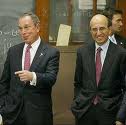The U.S. Census Bureau has released elementary and secondary school finance data for fiscal year 2007, and I’m pleased to see one publication has already covered it and done a computation or two. My contribution is summarized in the attached three spreadsheets. The numbers are available, and anyone is free to interpret them.
My main finding is that FY 2007 is the year that New York City public school spending, very low a decade earlier, went over the moon, soaring to an extreme high of $19,336 per student (all future figures on that basis), compared with the national average of $11,556. It is almost as high as the Downstate Suburban average of $20,120, and is far above the average for New Jersey ($18,094) and Massachusetts ($14,422). Even adjusting downward for the higher general wage rate here (in the private sector excluding the Finance and Insurance sector), New York City came in at $14,129, still a solid 22.3% above the national average and just below the Downstate Suburbs ($14,767) and New Jersey ($14,876) though well below Upstate New York ($15,632). That adjustment cuts Massachusetts to $12,764. For instructional spending alone NYC is now higher than any of those areas, meaning that funding is no longer an excuse for any educational deficiencies in the city – far from it. From FY 2002, the last budget before Bloomberg, to FY 2007, however, New York City’s extra spending did not go to administration, no matter what you hear, nor for the most part to higher teacher pay or smaller class sizes. It went to soaring spending on debts and employee benefits such as pensions and retiree health care, a shift the city had in common with other areas. Contract spending also rose.

 The State Appeals court recently ruled against the City of N.Y that wanted to close the schools for low performing results, in favor of the United Federation of Teachers and the NAACP.
The State Appeals court recently ruled against the City of N.Y that wanted to close the schools for low performing results, in favor of the United Federation of Teachers and the NAACP.